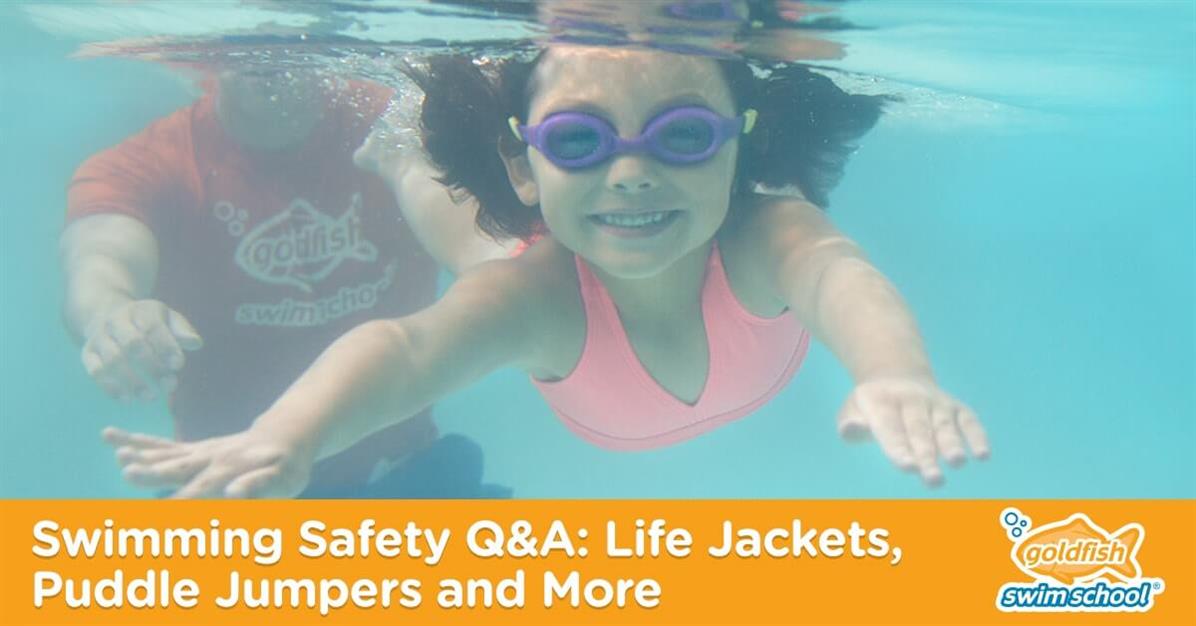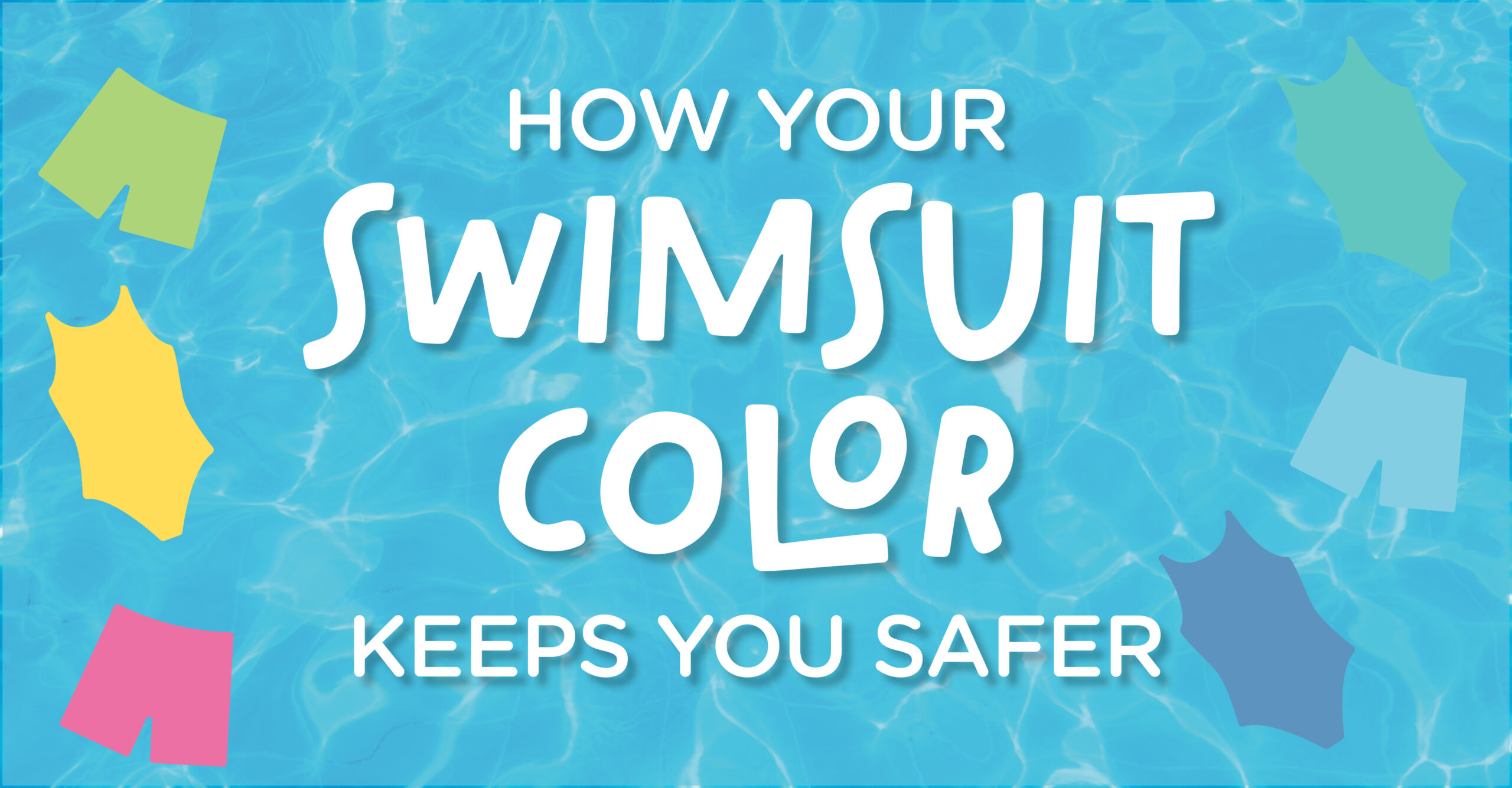Swimming Safety Q&A: Life Jackets, Puddle Jumpers and More

Parenting is full of decisions, and learning what to do in new situations – like should kids learn to swim while wearing a flotation device, and when is it OK for your child to swim without a life jacket?
At Goldfish Swim School, water safety is something we take very seriously – and teach in every lesson. We want you to have the tools you need to keep your family safe, so here are our answers to some popular swimming safety questions:
Should my child learn to swim with a life jacket, puddle jumpers or water wings on?
When your child is learning to swim with a qualified swimming instructor, like the ones at Goldfish Swim School who use integrity, compassion and trust to teach such a lifesaving skill, then generally personal flotation devices are not needed.
Plus, at Goldfish Swim School, we feel that learning to swim without some sort of flotation device actually helps kids build their confidence in the water quicker! (And if your child has special needs we would love to talk to you and figure out what works best.)
Think about it: Those bulky swim life jackets can hinder proper swim movements and backtrack progress when it comes to swimming without the device. Plus, water wings aren’t U.S. Coast Guard-approved flotation devices, and they can slip off or leak air. The same goes for those bathing suits with the floaty built in: It can ride up and not provide the safety you expect it to.
When should my child wear a life jacket while swimming?
When to put your child in a life jacket while swimming at the beach or a pool is your decision, since you – as the parent- know your child best and you know the situation. Varying factors like your child’s skill level with swimming, type of water and the constant supervision you’ll be providing (right there next to her, or watching from a few feet away).
But that’s why swim lessons at Goldfish Swim School are important: They provide extraordinary results that helps you gauge your child’s ability to be safer in the water.
Life jackets save lives, as does being able to recognize the signs of drowning (because it’s not the flailing arms like so many movies depict!). We want to make sure that every time you go swimming, you have a GOLDEN experience!
When does my child need to wear a life jacket on a boat or other water vessel?
Even if your child knows how swim, accidents can happen on a boat that render your child unconscious or unable to use his or her swim skills – so a life jacket must ALWAYS be worn on a boat. Laws vary by state, but generally if your child is younger than 13, is above deck and could potentially land in the water – either accidentally or on purpose – he or she needs a U.S. Coast Guard-approved life jacket. That’s according to the U.S. Coast Guard, so when in doubt follow that rule – though your state law may differ.
And you’ll likely need one life jacket per every person aboard the vessel – and it must be ready to use, meaning it can’t be still in the packaging.
What type of swim life jacket should my child wear?
It can be confusing when you go to the store to buy a life jacket for your child and there are different types, but it’s vital the swim life jacket you use has the USCG approval on it – AND the life jacket must fit your child properly right now (not when he or she grows a little bit!). The fit matters because if your child’s head or ears can slip down beneath the life jacket, the device won’t be able to work as designed to keep the child’s head above water and allow for proper breathing.
That being said, there are four types of Personal Flotation Devices:
- Type I: This life jacket floats a person the best and is able to keep most unconscious wearers face-up, and for longer periods of time – which is vital to life saving.
- Type II: This kind is nearly the same as the Type I, and it’s less bulky and costs less. It turns most wearers face up and is better when there’s a chance for a faster rescue.
- Type III: This flotation aid is better for active water sports because of the freedom of movement, but it doesn’t always turn wearers face up easily.
- Type IV: These are life-saving devices, such as rings, cushions and horseshoe buoys you can throw in an emergency. They are great to have on hand, but not something you should rely on to keep your children safe.
Are puddle jumpers safe?
There has been a fair amount of criticism leveled at puddle jumpers that questions their safety. One main critique of this flotation device is that it teaches children incorrect posture for swimming. Rather than helping children learn how to orient horizontally in water, puddle jumpers put children in an upright, vertical position. Unfortunately, this is the drowning position. Another criticism would be that they provide a false sense of safety. For children, the danger is assuming that they can float unassisted. They may not understand that, to stay above water, they need to perform swimming, water treading, or back floating movements. For parents, there may be danger of decreased adult supervision for children who cannot swim on their own. Generally, the better way to keep kids safe in the water is to teach them how to swim rather than relying on flotation devices.
Learn to swim at Goldfish Swim School
We have several levels of classes at Goldfish Swim School for kids of all ages to learn to swim (and yes, even babies as young as 4 months old can learn to swim!). Find a Goldfish Swim School location near you and and celebrate our WOW! customer service that helps make Goldfish Swim School a stroke above the rest. Sign up for swimming lessons for toddlers and kids today.



